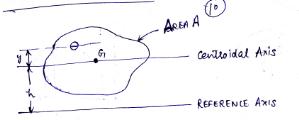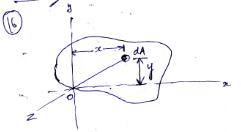Site pages
Current course
Participants
General
MODULE 1. BASIC CONCEPTS
MODULE 2. SYSTEM OF FORCES
MODULE 3.
MODULE 4. FRICTION AND FRICTIONAL FORCES
MODULE 5.
MODULE 6.
MODULE 7.
MODULE 8.
19 April - 25 April
26 April - 2 May
LESSON 9. Radius of Gyration of an area about an Axis
9.1 PARALLEL AXIS THEOREM
Statement – Moment of inertia of an area about any reference axis is equal to the sum of moment of inertia of the same area about its centroidal axis parallel to reference axis and the product of area and the square of the distance between the reference and centroidal axes.
Iref = Icent + Ah2 (9.1)

Fig.1 Parallel Axis Theorem
An axis passing through the centroid C of an area is called centroidal axis. The theorem can be proved as:
The moment of inertia of an area about a given reference axis is written using Eq.(8.3a) as
Iref = ∫(h+y)2 dA
Here (h+y)2 = h2 + 2hy +y2
Therefore,
Iref = ∫h2 dA + ∫2hydA + ∫y2dA
Iref = h2∫dA + 2h∫ydA + ∫y2dA
In the above expression ∫y2dA = Icent as per Eq.(8.3a), ∫dA = A and ∫ydA = first moment of an area about centroidal axis which will be equal to zero.
Hence, Iref = h2A + Icent
or Iref = Icent +Ah2
Example: The area in Fig… is symmetrical with respect to the x and y axis. The area is 150 m2 and the moment of inertia with respect to the ‘b’ axis is 4200 m4. Determine the moment of inertia of the area with respect to the ‘a’ axis.
Solution: According to the parallel axis theorem,
Ib= Icent +Ah2
4200 = Icent + 150(4)2
Icent = 2400 – 4200
Icent = 1800 m4
Ia = Icent +Ah2
= 1800 + 150(6)2
Ia = 7200 m4
9.2 PERPENDICULAR AXIS THEOREM
Statement: Moment of inertia of a plane area about an axis perpendicular to the plane of the figure (z-axis) is equal to the sum of moment of inertia of the same area about two rectangular axes in the plane of the area (x and y axes).

Fig.2 Perpendicular axis theorem
Iz = Ix + Iy (9.2)
According to the definition of moment of inertia [Eq.8.3a] about z-axis is given by
Iz = ∫r2dA
From Fig. 2, r2 = x2 + y2 can be used.
Therefore,
Iz = ∫(x2+y2)dA
Iz = ∫x2dA + ∫y2dA
Iz = Iy + Ix
Or Iz = Ix + Iy
9.3 MOMENT OF INERTIA OF GEOMETRICAL FIGURES ABOUT CENTROIDAL AXES
Using parallel Axis Theorem and moment of inertia of geometrical figures about one of their edges, the moment of inertia about their centroidal axis can be determined. Centroidal moment of inertia for a rectangle, triangle, semicircle and quarter circle are obtained as follows:
9.3.1 Rectangular Area
Moment of inertia of a rectangle about x-axis as shown in Fig.3 is given as [Eq.(8.5)]
Ix = \[{{b{d^3}} \over {12}}\]
Fig.3 Moment of inertia of a rectangle about its centroidal axis
From parallel axis theorem,
Icent = Iref – Ah2
Icx = Ix – Ah2 = \[{{b{d^3}} \over 3} - bd\] \[{\left( {{d \over 2}} \right)^2}\]
Icx = \[{{b{d^3}} \over {12}}\] (11.12a)
Similarly
Icx = \[{{b{d^3}} \over {12}}\] (11.12b)